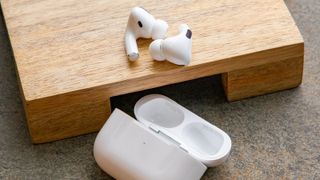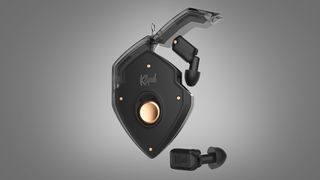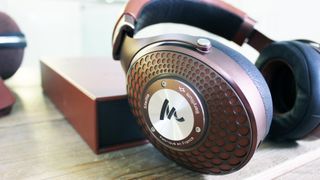When the best headphones have such good software, does hardware even matter?
Today’s headphones need the best of both worlds

Headphones are getting better and better, with advances in audio engineering coinciding with breakthroughs in wireless technology, active noise cancellation, and AI sound processing allowing for the very best headphones to become more accessible than ever.
Check out TechRadar's exhaustive guides to the best headphones you can buy today:
Once upon a time, the way a pair of headphones sounded depended largely on the way they were constructed; the size of the drivers, the quality of the materials, their shape and form factor.
Nowadays, however, digital signal processing (DSP) is an increasingly important deciding factor in the way our headphones sound – and as technology advances, this software is capable of improving the audio quality of headphones that would otherwise be held back by cheaply-made hardware.
While DSP has been around for decades, the audio world’s increasing adoption of the technology has led to an influx of high-spec headphones at accessible prices, with features like active noise cancellation, voice recognition, built-in equalizers, and even virtual surround sound becoming more commonplace – even in compact true wireless earbuds.
Audio characteristics that were once the domain of expertly crafted, high-end headphones, are now achievable without the need for expensive materials and large, powerful drivers – which begs the question: is great headphone hardware still important in the age of DSP?
We spoke to US loudspeaker and headphones company Klipsch and the Swedish audio processing company Dirac about their new partnership and what it means for the relationship between hardware and software in both companies' quest to build the best headphones they can without breaking the bank.
What is digital signal processing?
Digital signal processing is a technology found in most modern audio devices, from headphones to the smartphone in your pocket.
Get daily insight, inspiration and deals in your inbox
Get the hottest deals available in your inbox plus news, reviews, opinion, analysis and more from the TechRadar team.
It’s built into these devices via a chip, which is designed to speed up audio algorithms – these algorithms can be used to accommodate any shortcomings that arise as a result of the hardware.
Active noise cancellation in true wireless earbuds is a great example of DSP in action. In the past, headphone manufacturers relied on physical hardware to prevent environment sound from leaking into the headphones and ruining your music.
This was achieved through thick, heavily-padded earcups that completely encircled the ears, physically blocking outside sound from reaching your ears.
In-ear headphones are also able to replicate this effect (known as passive noise isolation) through the use of silicone or memory foam ear tips, which fit snugly in your ear to create a tight seal, stopping environmental sounds from entering.
These methods have their drawbacks however, and you’ll be hard-pressed to find a pair of regular earbuds that are able to fully block out environmental sound – they simply are capable of providing a strong enough physical barrier against the outside world.
That's where DSP comes in. It works by using microphones built into the headphones to analyze environmental noise and create 'anti-noise' frequencies that are mixed in with your music playback. This effectively cancels out the sound of your surroundings using analogue or digital filters.

Innovations in active noise cancellation has meant that even tiny true wireless earbuds like the AirPods Pro and the Sony WF-1000XM3 are able to block out environmental sound, despite not having the padded earcups that were once a prerequisite for effective noise cancellation.
This is just one example of how DSP can be used to overcome the shortcomings of headphone hardware. According to Sound Guys, “there’s a DSP inside your smartphone to decode MP3 files, run the math for active noise cancellation, and recognize your voice when you say “Hey Google!”’.
As well as that, “DSP units are also found inside wireless headphones to convert Bluetooth codes back to analog signals, and in-home cinema speakers to decode data streams into a surround sound experience.”
- Read our Apple AirPods Pro review
A boost for physical shortcomings
Lars Isaksson, Business Director at Dirac, believes that making the perfect pair of headphones or earbuds requires the use of software.
“The key to great sound can be summarized in one word: balance," Isaksson tells us. "No resonances, no attenuated areas, nothing is overwhelming, everything is ‘just right’. Once you find that sweet spot for each earphone they typically bloom and sound full of life”.
Consistently good hardware is still important however, he concedes.
“The most important aspect of hardware quality to Dirac is production consistency. In some very low-cost earphones, we sometimes see a large variance between different earphones of the same model. But this is less of a problem nowadays since production quality has improved greatly the last decade. And we always make sure to get multiple earphone samples from different batches and factories to ensure we are making the right optimizations.”
For Dirac, a combination of both physical build and clever audio processing leads to the best-sounding headphones. According to Isaksson, “When you put state-of-the-art technologies and tools into the hands of some of the best engineers in the industry, to manually craft a tuning on a solid hardware design, magic happens.”
"Think of cars and the improved performance when carburetors were replaced with electronic fuel injection – this is a good analogy for how software can make the same fundamental engine sing on a whole new level.”
Vlad Grodzinskiy, Prod. Manager Klipsch
Product Manager at Klipsch, Vlad Grodzinskiy, agrees that this relationship is important when it comes to making headphones, saying that “hardware and software together can always perform better than either one alone. Apple has proven that time and time again.”
”Some things in the physical domain are simply impossible to overcome, that’s where software blends the boundaries," Grodzinskiy says. "Think of cars and the improved performance when carburetors were replaced with electronic fuel injection – this is a good analogy for how software can make the same fundamental engine sing on a whole new level.”
It's an exciting prospect – particularly as Klipsch earbuds already have a great reputation. The Klipsch T5 true wireless earbuds are among the best wireless earbuds you can buy in 2020, thanks to their warm, detailed sound, and great design.
Making great sound cheaper
It’s possible that the use of DSP could make the best headphones less expensive by replicating the sound of pricey drivers. As Grodzinskiy explains, Klipsch is hoping that its partnership with Dirac will help to “bridge the gap between a dynamic driver and a balanced armature”.
Dynamic drivers are known for their powerful bass frequencies, achieved by displacing lots of air, while balanced armature drivers are favored for their warm sound and high levels of detail – and they’re generally more expensive than dynamic drivers.
While hybrid drivers do exist, bridging this gap with Dirac’s audio software will likely prove more cost-effective for Klipsch, in theory addressing the shortcomings and playing up to the strengths of both driver types without increasing the price for consumers.

Saying that, you shouldn’t expect Klipsch earbuds to get materially cheaper in the near future. While both Isaksson and Grodzinskiy believe that audio processing can make cheaply-made earbuds sound better, Klipsch isn’t about to cut corners when it comes to production of their in-ear headphones – nor is it about to cut prices as a result.
The yet-to-be-released Klipsch T10 true wireless earbuds, for example, are set to cost $649 (around £490 / AU$930) when they launch in the next few months.
A launch date is still to be confirmed, despite the earbuds being announced at CES 2020 in January. As Gronzinskiy puts it, “to deliver such a high tech product in such a small form factor has proven to be no simple feat”.
The best of both worlds
That’s something else that DSP technology can help with: allowing smaller form factors like true wireless earbuds to impart a level of audio quality on a par with over-ear headphones.
Isaksson explains that “one of the difficulties of working within a tight space like the ear is that there’s only so much room before your hardware grows to a size that’s literally painful for the listener” – a problem that he believes Dirac’s audio software can help to overcome by solving “fundamental issues in audio hardware”.
"Good hardware will always be valuable, but it is not a substitute for good software."
Lars Isaksson, Business Dir. at Dirac
So how can we expect future Klipsch earphones to sound? Well, it won’t be miles away from other earbuds on the market right now. “Klipsch isn’t aiming to distort what an earphone is supposed to sound like, instead we aim to enhance clarity, depth, and detail,” Isaksson says.
While these are all qualities we look for in a pair of headphones, we can’t help but wonder whether all that digital processing could negatively impact the accuracy of the sound.

For many, the best headphones in the world deliver a sound that's as close as possible to the sound created by the artist in the studio, exactly as they intended their music to be heard.
That means headphones shouldn’t impart any of their own characteristics onto the sound, which to us, seems like a contradiction when software is added to the mix – a bit like when you spend ages crafting the perfect nonchalant ‘just got out of bed’ hairdo.
Unsurprisingly, Isaksson disagrees, saying that software is “a requirement” in the quest to create the perfect headphones. He explains: “Audio hardware design is a series of compromises between material, acoustics, size, cost, look-and-feel, and other things.
“If I want to hear my music reproduced as the artist intended it, I will always trust a carefully digitally optimized system over a completely analogue one. Good hardware will always be valuable, but it is not a substitute for good software.”
Equally, however, it seems that good software can’t replace good hardware – and today’s headphone-makers need to use both technologies to truly compete in an increasingly-competitive market.
Olivia was previously TechRadar's Senior Editor - Home Entertainment, covering everything from headphones to TVs. Based in London, she's a popular music graduate who worked in the music industry before finding her calling in journalism. She's previously been interviewed on BBC Radio 5 Live on the subject of multi-room audio, chaired panel discussions on diversity in music festival lineups, and her bylines include T3, Stereoboard, What to Watch, Top Ten Reviews, Creative Bloq, and Croco Magazine. Olivia now has a career in PR.
Most Popular



